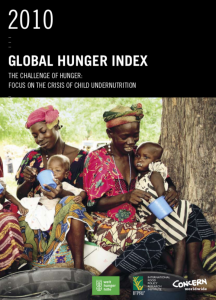Resource Title
2010 Global Hunger Index: focus on the crisis of child undernutrition
Summary
Now in its 5th edition, the Global Hunger Index has become the standard for tracking trends in the comparative levels of hunger in different parts of the world and across individual nations.
Organised annually by a leading theme, the 56 page report is designed for policymakers, antipoverty workers and advocates and is driven by two factors: the need for information (on how and why hunger is occurring) and the need for action (addressing the short, medium and long term causes of hunger).
Malnutrition among children under two years of age is one of the leading challenges to reducing global hunger and can cause lifelong harm to health, productivity, and earning potential, according to the 2010 Global Hunger Index (GHI).
Resource Details
Description
Now in its 5th edition, the Global Hunger Index is a joint research report by Concern Worldwide, the International Food Policy Research Institute (IFPRI) and German NGO Welthungerhilfe. The Global Hunger Index report ranks countries on three leading indicators:
- prevalence of child malnutrition;
- rates of child mortality;
- and the proportion of people who are calorie deficient
The indicators are then combined into one score. The higher the score, the more desperate the predicament of those affected. The Index is calculated for 122 developing and transition countries for which data on the three components of hunger are available.
According to the 2010 Index, 29 countries still have levels of hunger that are “extremely alarming” or “alarming.” The countries with “extremely alarming” 2010 GHI scores – Burundi, Chad, the Democratic Republic of Congo, and Eritrea – are in Sub-Saharan Africa. Most of the countries with “alarming” GHI scores are in Sub-Saharan Africa and South Asia.
The report is packed full of case studies, individual testimonies, beautifully laid out tables, maps, data sets, photos, illustrations and is ‘educationally friendly.’
As the world approaches the 2015 deadline for achieving the Millennium Development Goals (MDGs) – which include a goal of reducing the proportion of hungry people by half – the 2010 Global Hunger Index (GHI) offers a useful and multidimensional overview of global hunger. The 2010 GHI shows some improvement over the 1990 GHI, falling by almost one-quarter. Nonetheless, the index for hunger in the world remains at a level characterized as “serious.” The result is unsurprising given that the overall number of hungry people surpassed 1 billion in 2009, even though it decreased to 925 million in 2010.
A range of factors contribute to the crisis of early childhood undernutrition. Policy and program solutions, therefore, have to address the range of causes – both immediate and underlying. The report, therefore, makes several policy recommendations focussed on 5 levels of action:
- Target nutrition interventions to the window of opportunity
- Tackle the underlying conditions that cause undernutrition
- Foster gender equity
- Prioritize nutrition in political and policy processes
- Engage, empower, and ensure sustained support for those actors at the local and municipal levels whose capacities and skills will ensure that nutritional needs are addressed
Further reading:
Links to previous Global Hunger Index reports:
- Download 2011 Global Hunger Index: taming price spikes and excessive food price volatility [annotation+report]
- Download 2009 Global Hunger Index: focus on financial crisis and gender inequality [annotation+report]
Other information:
External websites:
- Concern Worldwide (Ireland)
- International Food Policy Research Institute (IFPRI) (USA)
- Welthungerhilfe (Germany)
- The Guardian news story on launch of the report (UK)
- The raw data, overlaid map and other information relating to the 2010 report are available on the IFPRI website
Available from:
- Download 2010 Global Hunger Index PDF
- Download 2010 GHI briefing paper PDF
- Link to video introducing the 2010 GHI (Youtube)

